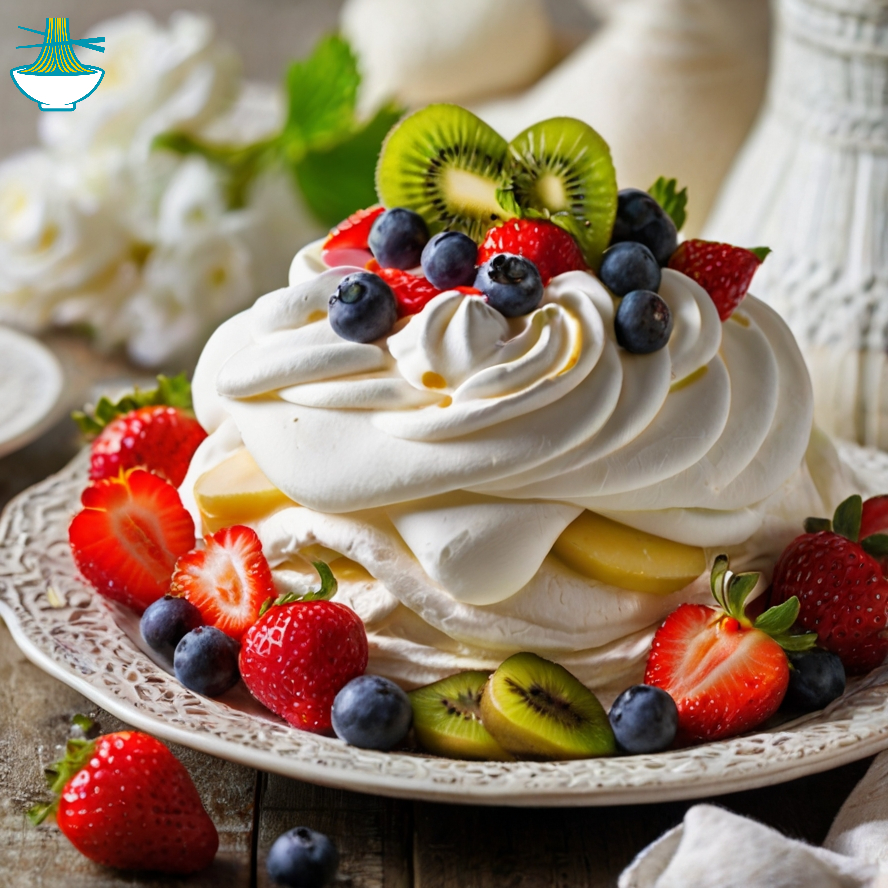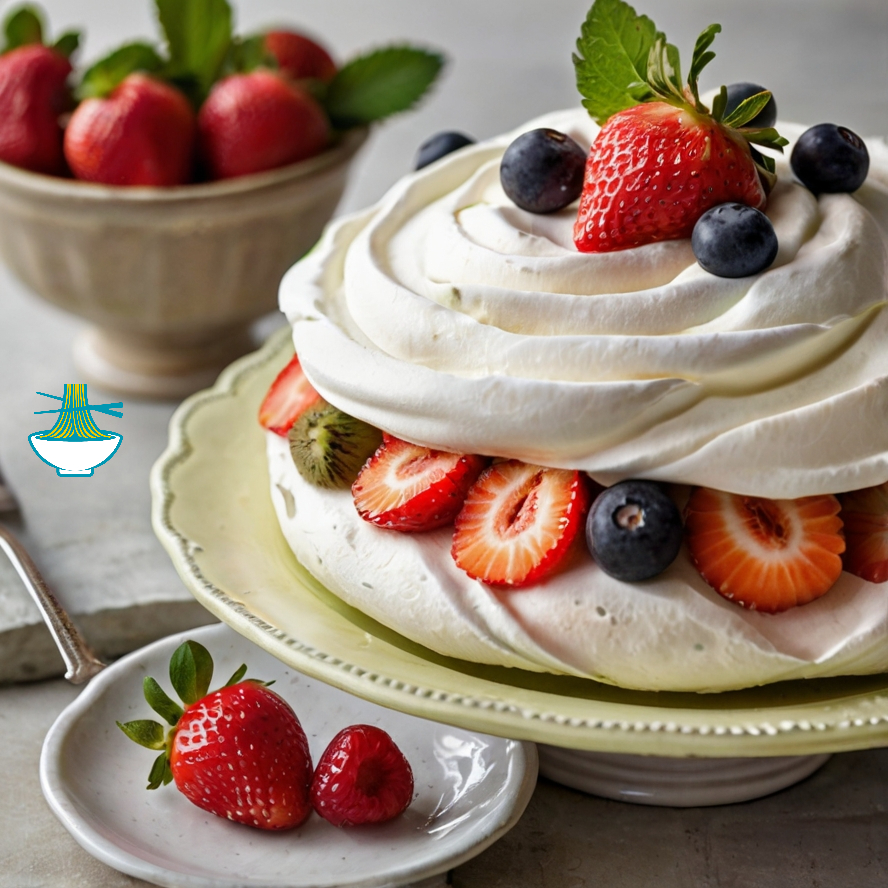Pavlova is a beloved dessert in Australia, named in honor of the famous Russian ballerina Anna Pavlova. This light, meringue-based treat is known for its crisp exterior and soft, marshmallow-like interior, offering a delightful contrast of textures. Typically topped with whipped cream and fresh fruits like strawberries, kiwi, and passionfruit, Pavlova is perfect for special occasions and impressing guests.
Not only is this dessert delicious, but it also provides various health benefits. The fruits used in Pavlova, such as kiwi and strawberries, are rich in vitamins like vitamin C, which supports immune health and collagen production. Kiwi, in particular, is packed with antioxidants and dietary fiber, which contribute to digestive health. However, despite its health benefits, it's important to note that the meringue can be high in sugar, which may not be suitable for those with dietary restrictions or those managing blood sugar levels. Thus, while Pavlova can be a tasty and occasionally indulgent treat, moderation is key.
Ingredients:
- 4 egg whites
- 1 cup caster sugar
- 1 teaspoon cornflour (cornstarch)
- 1 teaspoon white vinegar
- 1 cup whipped cream
- Fresh fruit (strawberries, kiwi, passionfruit)
Method:
- Preheat your oven to 150°C (300°F). Line a baking tray with parchment paper.
- In a clean, dry bowl, beat the egg whites until stiff peaks form.
- Gradually add the caster sugar, one tablespoon at a time, beating well between each addition until the mixture is glossy and stiff.
- Sift the cornflour over the meringue mixture, then add the vinegar and fold gently to combine.
- Spoon the meringue onto the prepared baking tray, shaping it into a large circle with a slight indent in the middle.
- Bake for 1 hour or until the pavlova is crisp on the outside but soft and marshmallow-like on the inside.
- Turn off the oven and leave the pavlova to cool inside with the door slightly ajar.
- Once cooled, top the pavlova with whipped cream and fresh fruit.
Notes:
- Use caster sugar instead of granulated sugar for a smoother, glossier meringue.
- Ensure all equipment is clean and free from any traces of fat, as even a small amount can prevent proper whipping of the egg whites.
- Feel free to customize the toppings with your favorite fresh fruits; strawberries, kiwi, and passionfruit are traditional choices.
Frequently Asked Questions:
Can I eat Pavlova if I am following a low-sugar diet?
- Yes, Pavlova can still be enjoyed on a low-sugar diet by replacing white sugar with healthier alternatives like stevia or monk fruit, which have little to no effect on blood sugar levels.
What are the available alternatives to make a healthier Pavlova?
- You can make Pavlova healthier by using sugar substitutes like stevia, and replacing whipped cream with low-fat or dairy-free alternatives such as coconut cream. Additionally, using more fruit as a topping and reducing the amount of sugar can enhance its nutritional profile.
Is Pavlova a healthy option for children?
- Pavlova can be a healthy dessert option for children when consumed in moderation. The fresh fruits provide vitamins and fiber, which are beneficial for growth and development. However, parents should be mindful of the sugar content and consider reducing it when preparing the dessert.
What other health benefits can be gained from eating Pavlova regularly?
- When made with fresh fruits, Pavlova can provide a good source of antioxidants, vitamins, and fiber. The fruit ingredients support immune health, digestive function, and skin health. However, it's important to enjoy it in moderation to avoid excessive sugar intake.
Can gluten-free ingredients be used in making Pavlova?
- Yes, Pavlova is naturally gluten-free since it is made primarily with egg whites, sugar, and fruits. However, when preparing the meringue, ensure that all other ingredients (such as cornstarch) are certified gluten-free to accommodate those with gluten sensitivities or celiac disease.

Nutrition Value:
1. 4 egg whites
- Calories: 68 kcal
- Carbohydrates: 0.8 g
- Protein: 14.8 g
- Fat: 0.2 g
- Sodium: 166 mg
- Cholesterol: 0 mg
- Vitamins: Rich in Vitamin B2 (riboflavin) and Vitamin B12
- Minerals: Contains calcium, potassium, and magnesium
Nutritional Benefit: Egg whites are a high-quality source of protein, low in calories and fat, and contain essential vitamins and minerals important for muscle repair and overall health
2. 1 cup caster sugar
- Calories: 773 kcal
- Carbohydrates: 200 g
- Protein: 0 g
- Fat: 0 g
- Sodium: 1 mg
- Cholesterol: 0 mg
- Vitamins: None
- Minerals: None
Nutritional Benefit: Caster sugar provides quick energy due to its high carbohydrate content but lacks vitamins and minerals. It contributes to the texture and sweetness of the pavlova
3. 1 teaspoon cornflour (cornstarch)
- Calories: 7 kcal
- Carbohydrates: 1.7 g
- Protein: 0 g
- Fat: 0 g
- Sodium: 0 mg
- Cholesterol: 0 mg
- Vitamins: None
- Minerals: None
Nutritional Benefit: Cornflour is used to stabilize the meringue, helping to achieve a light and airy texture. It adds minimal calories and no significant nutrients
4. 1 teaspoon white vinegar
- Calories: 1 kcal
- Carbohydrates: 0 g
- Protein: 0 g
- Fat: 0 g
- Sodium: 0 mg
- Cholesterol: 0 mg
- Vitamins: None
- Minerals: None
Nutritional Benefit: White vinegar helps stabilize the meringue by reacting with the proteins in the egg whites, aiding in the formation of a stable foam. It has negligible nutritional content
5. 1 cup whipped cream
- Calories: 51 kcal (per 2 tablespoons)
- Carbohydrates: 0.4 g (per 2 tablespoons)
- Protein: 0.3 g (per 2 tablespoons)
- Fat: 5.5 g (per 2 tablespoons)
- Sodium: 6 mg (per 2 tablespoons)
- Cholesterol: 22 mg (per 2 tablespoons)
- Vitamins: Contains Vitamin A
- Minerals: Contains calcium
Nutritional Benefit: Whipped cream adds a rich flavor and creamy texture to the pavlova. It provides some essential nutrients like Vitamin A and calcium but is high in fat and cholesterol
6. Fresh fruit (strawberries, kiwi, passionfruit)
Strawberries
- Calories: 32 kcal (per 100 g)
- Carbohydrates: 7.7 g (per 100 g)
- Protein: 0.7 g (per 100 g)
- Fat: 0.3 g (per 100 g)
- Sodium: 1 mg (per 100 g)
- Cholesterol: 0 mg (per 100 g)
- Vitamins: Rich in Vitamin C and folate
- Minerals: Contains potassium and manganese
Nutritional Benefit: Strawberries are low in calories and rich in Vitamin C, which supports the immune system and skin health,and promotes collagen production for healthy skin ,They also provide antioxidants and fiber
Kiwi
- Calories: 61 kcal (per 100 g)
- Carbohydrates: 14.7 g (per 100 g)
- Protein: 1.1 g (per 100 g)
- Fat: 0.5 g (per 100 g)
- Sodium: 3 mg (per 100 g)
- Cholesterol: 0 mg (per 100 g)
- Vitamins: High in Vitamin C, Vitamin K, and Vitamin E
- Minerals: Contains potassium and magnesium
Nutritional Benefit: Kiwi is nutrient-dense with high Vitamin C content, which boosts the immune system and promotes healthy skin. It also contains dietary fiber and antioxidantswhich contribute to heart health and may lower the risk of chronic diseases.
Passionfruit
- Calories: 97 kcal (per 100 g)
- Carbohydrates: 23.4 g (per 100 g)
- Protein: 2.2 g (per 100 g)
- Fat: 0.4 g (per 100 g)
- Sodium: 28 mg (per 100 g)
- Cholesterol: 0 mg (per 100 g)
- Vitamins: High in Vitamin C and Vitamin A
- Minerals: Contains potassium and iron
Nutritional Benefit: Passion fruit is rich in vitamins A and C, which contribute to overall health and immune function. It also provides dietary fiber that aids digestion and antioxidants that boost immune function. Not only does this fruit add flavor, it also boosts the nutritional value of the dessert, making it a more balanced meal.


Comments